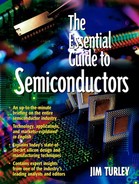Let's Get Small
What exactly are these engineers measuring with their very small rulers? They measure something they call effective length, often abbreviated Leff in engineering lingo. Broadly speaking, the effective length is the thickness of the thinnest thing that can be manufactured reliably. Effective length depends very much on the maturity of the fab and its equipment, the experience of the technicians in the clean room, the company's tolerance for risk versus aggressiveness, and the amount of money it's willing to invest in the process. The best (i.e., the smallest) effective length achievable varies from company to company, and even from fab to fab within a company. Some large companies operate a few fabs on the cutting edge of current technology while keeping a few other fabs one half-step back, running at more conservative dimensions. This allows them to produce both very fast chips (with risky yield profiles) and very reliable chips (with commensurately higher yields).
The state of the art in fab technology moves in distinct jumps every few years. In years past, the best companies were producing 0.25-micron transistors. Then these companies made a change to 0.18-micron processes, more or less all at once. Following the 0.18-micron generation came the 0.13-micron generation, and so on. The reason these firms—competitors all—adopted the same technology simultaneously is that they bought it from the same suppliers. With very few exceptions, chip manufacturers don't make their own chip-making equipment; they buy it on the open market. The situation is not dissimilar to warring countries buying weapons from the same small group of arms merchants.
The number of these silicon merchants is shrinking. It gets harder and harder to develop machines that can produce finer and finer slivers of silicon. Indeed, many well-informed industry observers predicted that we'd never get this far. Serious technical obstacles reared their heads in past years that threatened to put a stop to Moore's Law and halt the continual rate of improvement we've come to take for granted. Yet each time, semiconductor equipment suppliers have found more elaborate (and expensive) solutions to these problems. However, the staggering cost of research and development into these technologies weeds out a few suppliers at each process generation. Now former competitors are cooperating, sharing the multibillion-dollar development costs of reaching the next step in semiconductor evolution.
A big part of the challenge is finding sources of light with short wavelengths that are bright and strong enough to resolve small, sharp images into a wafer. As the effective length of film features gets smaller and smaller, it's harder and harder to project a sharp image onto a wafer's photoresist. Every process shrink, from 0.18 micron (180 nanometers), to 0.13 micron (130 nanometers), to 90 nanometers, and so on, makes projecting accurate images tougher. The light tends to bend around the microscopically small features on the film, blurring the image and ruining the chip.
Equipment makers have been experimenting with exotic-sounding techniques like i-beam lithography, e-beam epitaxy, x-ray sources, and extreme ultraviolet (EUV) lithography. Each approach has its pros and cons, and researchers are likely to develop at least two into working equipment. Despite the recurring cries of Chicken Little, the sky appears to stay firmly above the heads of the developers of this vital technology.
